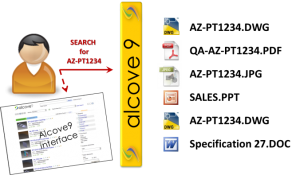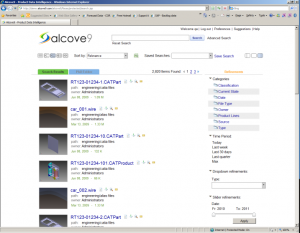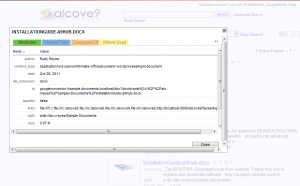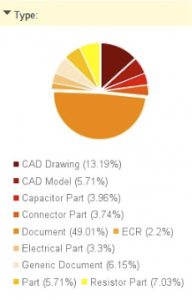a9 Hub is a simple, browser-based, Google-like search-based application (SBA) powered by an open-source search engine that works within a company’s security policies. As a Unified Information Access (UIA) solution, a9 offers unique features aimed at drastically improving efficiency and collaboration among team members, allowing them to rapidly search for, find, view and act on any accessible data asset, keeping critical data at their fingertips.
Feature Details
Alcove9 products maintain the same groups, roles, and access control lists (ACL) that are built into your native applications.. In this way, data security is retained while giving users search capability across multiple data silos.
Since Alcove9 products inherit your security roles and responsibilities, there is no additional burden for the system administrator.
 Alcove9 provides a single point-of-access via its a9 Hub to all enterprise data contained in multiple Product- and Part-oriented applications and repositories, including PDM/PLM, ERP, ECM, MES, RM and simple file structures (see a9 CADViz and a9 AppConnect). For example, a user searching for all relevant information about a part might find the latest design revision in PLM, a BOM in ERP, an Excel spreadsheet and a Word document – all in just one search.
Alcove9 provides a single point-of-access via its a9 Hub to all enterprise data contained in multiple Product- and Part-oriented applications and repositories, including PDM/PLM, ERP, ECM, MES, RM and simple file structures (see a9 CADViz and a9 AppConnect). For example, a user searching for all relevant information about a part might find the latest design revision in PLM, a BOM in ERP, an Excel spreadsheet and a Word document – all in just one search. Alcove9’s UI can be configured to optimize searching results. The user organization can predefine colors, logos, layouts, refinements, saved searches and widget preferences. These options can be defined at either the enterprise and/ or the user level.
Alcove9’s UI can be configured to optimize searching results. The user organization can predefine colors, logos, layouts, refinements, saved searches and widget preferences. These options can be defined at either the enterprise and/ or the user level. Each search result has a Virtual Profile Card (VPC) attached to it. These cards contain information about the object’s attributes, related data, and assembly information – each with their own tab. Intuitive navigation with an object’s VPC provides greater visibility for users.
Each search result has a Virtual Profile Card (VPC) attached to it. These cards contain information about the object’s attributes, related data, and assembly information – each with their own tab. Intuitive navigation with an object’s VPC provides greater visibility for users.
- Each search item is analyzed for relationship and taxonomy data; for example, a user looking for “capacitors” could see information about capacitors organized by Type, Attributes, Supplier, or Content Source.
- Attributes: Information from an object’s properties, xref, or title block.
- Related Data: A list of similar data based on configurable preferences.
- Assembly Information: Where-used and composed-of information.
 Intuitive search options provide search and discovery capabilities. Each search and each object has a trail or location that is visible for reference. Keyword searches can be refined based on advanced search options or pre-configured search refinements. Refinements can be assigned to many widgets that have been developed including drop down menus, slide bars, pie charts, and checklists.
Intuitive search options provide search and discovery capabilities. Each search and each object has a trail or location that is visible for reference. Keyword searches can be refined based on advanced search options or pre-configured search refinements. Refinements can be assigned to many widgets that have been developed including drop down menus, slide bars, pie charts, and checklists.




